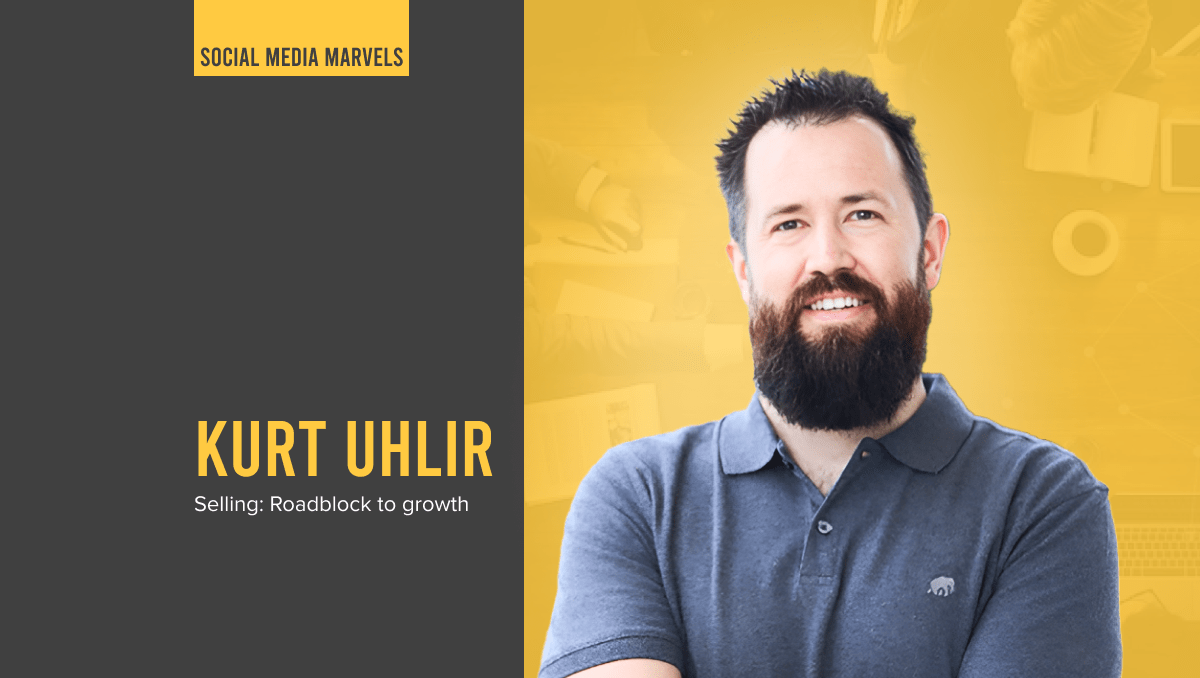This week on the Social Media Marvels, we spoke to Showcase IDX’s CMO, Kurt Uhlir. We talk about the innovation and marketing, how important it is to communicate with your audience. He feels communication is key to problem-finding and then bringing about an innovative solution around it.
Find the summarized
What Do I Expect from the Video :
- Innovation as a growth tactic – how to work it for you even in the short-term.
- Communicating with the audience is the key factor to growth.
- Is there a difference in strategy between high-growth and growing companies?
- An ideal marketing mix strategy.
Q – Could you introduce us to the topic and your role around it?
A – I’ve come from corporate finance where I actually led teams coding software for high end financial stuff and that took me into leading innovation for a large company that we ended up taking public where I ran much of our marketing there.
Became a little bit of a social media influencer myself. I was verified on Twitter very early on thanks to some investments that I had made around Chicago as well and then I, for the last probably eight years, I’ve run marketing for high growth technology companies in the States that have had a couple of really good exit spot by some big companies. I’ve advised President of The United States, which has been good on technology, innovation and American business and now I’m leading technology for a real estate company.
Q – Innovation takes a long time. But can a business look at it to gain traction in the short term as well?
A – Leveraging innovation as a short-term goal requires having conversations with your potential customers. These conversations aim not to sell products, but develop them.
Getting into this mindset is important when it comes to innovating in the short-run.
For example, as a tech company offering solutions to real estate owners, I had spoken with around 200 agents. Challenges I faced were in terms of making them believe, “I’m not here to sell anything, but actually to listen to your problems.”
It is easier to get a conversion when the company has heard what the consumers want, and deliver it. Six months down the line, when I had to call those agents again, they wanted to hear about the solution, I had to offer.
When it comes to understanding marketing teams, they lack using the correct words. If a marketer can speak in a language which the consumer understands, converting them becomes a lot easier.
Q – How important is it to speak in the language of the customer? How can you simplify a concept like Cryptocurrency, for example?
A – I’m a huge fan of what I think Bitcoin will or Blockchain will end up, maybe Bitcoin has one implementation but Blockchain will end up but I think most companies that are using anything Blockchain related, they’re using it almost as a marketing gimmick or even to raise funds on a gimmick.
Now with that said, I’ve invented some Blockchain technology but we explained it without using Blockchain as the core concept, even to our legal team and now some of that has gone into patent applications but from a marketing to the company, how products are built, consumer products are built and none of the Blockchain related stuff may ever really get discussed to consumers because consumers don’t care. They just care about getting a different product.
Q – Passion is key to succeeding at anything. How do you imbibe your passion for the product towards engaging with your audience better?
A – I agree. But recognizing that passion is a journey in itself. For me personally, serving people is where my passion lies.
I had been pulled in different directions. But I always managed to find my way back. Innovation is a part of that process. I work towards solutions that actually help my customers. And how do I figure out whether it is the right product or not? I talk to people.
It is because of my passion towards people and the product I build, customers are drawn in towards my solutions. My team also follows the same principle. Hold conversations. Figure out what’s not working. Innovate by listening.
But it is not always easy to find the correct set of problems. You need to probe, console, separate the noise to get the information you are actually looking for. This requires a curious mind. People looking to ask questions and discover answers.
Q – Since you’ve worked across various industries, which ones have been the hardest to innovate in?
A – Automotive was the hardest to innovate with. They were used to processes which had been long-standing. They understood the language of building physical things like the door, engine, etc.
But introducing software in a machine was unexpected. They wanted to introduce the aspect, but were not equipped to build that sort of technology. Hence, I worked with them externally. Our struggles were manifold. We spoke different languages, convincing took time, we were sort of pioneers – saw the market grow. We also had different iteration cycles – with software, our cycles lasted a couple of weeks, but with automotive it lasted a couple years.
We overcame these and eventually things worked out – today’s cars almost all have software integrated in them.
Q – So it’s an evolution, a time-consuming process. In some industries it’s even protected for longer spans of time. Is there a way to hasten the replication of the innovative process?
A – This is where social media comes in the picture. Industries with longer iteration cycles can keep tabs on where the customers are. I keep looking at my Twitter feed to understand what various customers are looking for. Social listening, knowing what your potential audience wants, paves the path for innovation.
Q – Is there a different strategy to innovate and scale, for companies which have witnessed a spurt of growth already, and companies which still have the potential to grow?
A – The company I work for has seen both phases – growth spurt and potential to grow. When I joined, the company had a great product, good market share, and potential to grow further. All the elements were in place.
But to get the elements aligned, requires good marketing leadership. It requires having conversations with people, understand their perspectives, pain-points, and how can your product be the convenient solution.
When market leaders, employ experts and witness growth, it is because they look at the data, and understand what is working and what needs to be worked on. Understanding mindset and putting across the right messaging is important for growth.
Hence, companies that have grown, require innovation in terms of strategy rather than execution. It’s about making small changes, growing teams, communicating. It is important to know what is working and what’s not. Letting the team know about your findings, giving them time to adjust their execution methods.
I have had more blow ups with high growth companies over working with potential growth companies. It’s because with the latter, margin for error is acceptable. With growth companies, this error should be grossly minimized as it has large scale effects.
Q – When you are running your own company, how important is it to also have a personal brand besides the brand of the company?
A – It isn’t that important. But, if as a founder, you do hold the skill of influence and communication, why not leverage it?
Why is it advantageous? One, you have the product that solves actual problems. Two, it helps you connect at a human level. Your business, customers, teams, no matter how remote, more often than not, connect with your product through a human.
Hence, connecting through the right messaging, with a face attached, brings the potential customer closer. They are able to retain and place a direct connect with product and it’s messaging.
Founders also need to understand, companies fail. I have seen so many founders gaining traction in their 2nd or 3rd company due to a strong personal brand. Once you carry a certain expertise, making that call for the next product becomes easier.
Q – An ideal marketing mix or strategy which is conducive to steady growth and supports innovation?
A – It depends on which industry you are in. And also where your audience is ready to interact with you.
I have clients whose digital presence is limited while they attend a lot of conferences, events, expos. It is because they were selling to electrical and plumbing companies. Although, these clients had social presence, they were seen at expos and events the same.
I try and move the needle by putting more efforts digitally. I do speak at conferences, as well. Speaking at these events helps me convert, hold conversations, collaborations. This is where I source my sales growth.
But working on digital is equally important. We use it for messaging, promoting, it is where people from the same niche interact. We also incorporate direct social media outreach in our strategy.
Q – Does collaboration breed innovation? Can companies within similar industries cross-collaborate to grow and innovate faster?
A – I am a big believer of partnerships. Small companies can collaborate in terms of design or content. But for knowledge partnerships, bigger companies need to take the leap.
I mentioned about speaking at events. I can collaborate with any Chamber of Commerce in exchange for a waived fee, but around 500 potential leads. I have the chance to talk to these people, and recognize the innovation potential. Besides getting to know the problems, I benefit from adding more value to others, thus building a lasting relationship.
Talking to people across various industries and explaining them my product brings up questions which aids in me innovating the way I look at my current product. This continues the innovation further, I discover different questions and gauge different solutions.
Digging a little deeper into the life of “The Kurt Uhlir”..
As far as personal struggles, when you’re trying to go out as I mentioned, have 200 phone calls in the first week or two weeks to talk to people, that can go really well and it can go really bad because you never know what’s going on in the other case.
We were working on a company that we brought through Georgia Tech and some research there and we had called up a woman who ran marketing for a very large company in the US. It was the third or fourth phone call we had with her and the first two phone calls went great. We thought we were calling to be able to have a conversation about selling a product that we were going to go and build and we still have no idea to this day what happened with her but she said things on that call that was basically that we should question our belief about being alive as humans that would take the time to call her.
I have no idea what happened job wise, personal wise that day but we even went back and looked at her notes. We had recorded the previous call. It just was so not aligned and that was really hard for us at that time even though we knew what she was speaking was not true. There’s that roller-coaster and that roller-coaster happens when you’re trying to really drive growth and innovation and talk to people to really find out where you’re wrong and that’s, is both good and bad.
You have to develop some thick skin for it and I’ve gotten a lot better at it. Thankfully I have a wife that’s really good when I come home and she’ll ask me, is this, she’ll ask me some of those questions to let me realize, oh that was just a bad day that we were having. Tomorrow is going to be a different day.
But I find when you’re really pushing for growth and innovation and you’re asking questions, I mean I wake up everyday knowing that I’m wrong about three to four major things in my business and my marketing everyday. There’s three to four things. So it’s more of, am I going to figure it out today or not. So I’m going to ask questions and so when I’m taking that kind of curious approach about myself, humbly admitting I could be doing something three times better, five times better, I mean I’m called a ten x marketer. But maybe I could be a 50 x marketer if I could figure out what I could be doing better today. That just lets me also change some of the disadvantages and advantages.
The #SocialMediaMarvels is a podcast series that invites digital marketing influencers from across the world to celebrate their journey and get a glimpse of their contributions to the field. Get actionable tips, learn directly from the practitioners, and imbibe it to help your business.


